Maeve O'Meara explores the exquisite fresh flavors of Japanese food with the help of a range of top chefs and home-cooks who are passionate about their delicious and complex cuisine.
Maeve joins her friend, legendary award-winning chef and restaurateur Tetsuya Wakuda who gives tips on the top ingredients needed for Japanese cooking and makes a delicious simple recipe using just 5 ingredients including his favorite miso (soybean) paste—a meltingly delicious marinade for meat and fish.
Top restaurateur Kimitata Azuma gives the secrets to making a fast fresh tuna salad which is very easy to make—he’s predicting this will be the number one easy recipe of the summer.
Home-cook Yuki Totsuka shows how easy it is to make your own miso soup—far superior to the version in restaurants. We also meet sushi master Shinji Tani who reveals some of the secrets of his art, and knife expert Hideo Dekura who slices sashimi.
Vibrant mother and daughter cooking team Kei and Masako Fukui have taught the art of the kaiseki banquet for many years, and show how to make sushi rice and roll it into exquisite nori maki rolls. We finish with a range of noodles–the prized buckwheat soba noodles and ramen—and Maeve has a lesson in the fine art of slurping.
Click here for the recipes featured in this episode.
About Japan
The Japanese name for Japan is Nippon, which is used for most official purposes, including on Japanese yen, postage stamps, and for many international sporting events. Nippon means "sun-origin" and are often translated as "Land of the Rising Sun".
Japan is an island nation in East Asia. Located in the Pacific Ocean, it lies to the east of the People's Republic of China, North Korea, South Korea and Russia, stretching to Taiwan in the south.
Japan is an archipelago of 6,852 islands. The four largest islands are Honshū, Hokkaidō, Kyūshū and Shikoku, together accounting for 97% of Japan's land area. Japan has the world's tenth-largest population, with over 127 million people. The Greater Tokyo Area, which includes the de facto capital city of Tokyo and several surrounding prefectures, is the largest metropolitan area in the world, with over 30 million residents.
Archaeological research indicates that people lived in Japan as early as the Upper Paleolithic period. The first written mention of Japan is in Chinese history texts from the 1st century AD. Influence from other nations followed by long periods of isolation has characterized Japan's history. In the late 19th and early 20th centuries victory in the First Sino-Japanese War, the Russo-Japanese War, and World War I allowed Japan to expand its empire during a period of increasing militarism. The Second Sino-Japanese War of 1937 expanded into part of World War II, which brought to an end in 1945 by the atomic bombings of Hiroshima and Nagasaki. Since adopting its revised constitution in 1947, Japan has maintained a unitary constitutional monarchy with an emperor and an elected parliament called the Diet.
Economy:
As of 2011, Japan is the third largest national economy in the world, after the United States and China, in terms of nominal GDP, and the fourth largest national economy in the world, after the United States, China and India in terms of purchasing power parity. It is also the world's fourth largest exporter and fourth largest importer.
A mountainous, volcanic island country, Japan has inadequate natural resources to support its growing economy and large population. Because of political decisions on local, prefectural, and nation levels, Japan decided not to exploit its forest resources for economic gain. Deposits of gold, magnesium, and silver meet current industrial demands, but Japan is dependent on foreign sources for many of the minerals essential to modern industry. Iron ore, copper, bauxite, and alumina must be imported, as well as many forest products.
The service sector accounts for three quarters of the gross domestic product. Japan has a large industrial capacity, and is home to some of the largest and most technologically advanced producers of motor vehicles, electronics, machine tools, steel and nonferrous metals, ships, chemical substances, textiles, and processed foods. Agricultural businesses in Japan cultivate 13% of Japan's land, and Japan accounts for nearly 15% of the global fish catch, second only to China.
Japan ranks 12th of 178 countries in the 2008 Ease of Doing Business Index and has one of the smallest tax revenues of the developed world. The Japanese variant of capitalism has many distinct features: keiretsu enterprises are influential, and lifetime employment and seniority-based career advancement are relatively common in the Japanese work environment. Some of the largest enterprises in Japan include Toyota, Nintendo, NTT DoCoMo, Canon, Honda, Takeda Pharmaceutical, Sony, Panasonic, Toshiba, Sharp, Nippon Steel, Nippon Oil, and Seven & I Holdings Co. It has some of the world's largest banks, and the Tokyo Stock Exchange (known for its Nikkei 225 and Topix indices) stands as the second largest in the world by market capitalization. Japan is home to 326 companies from the Forbes Global 2000 or 16.3% (as of 2006).
As of 2010, Japan's labor force consisted of some 65.9 million workers. Japan has a low unemployment rate of around four percent. Almost one in six Japanese, or 20 million people, lived in poverty in 2007. Housing in Japan is characterized by limited land supply in urban areas.
Although Japan has officially renounced its right to declare war, it maintains a modern military force in self-defense and peacekeeping roles. After Singapore, Japan has the lowest homicide (including attempted homicide) rate in the world.
Demographics:
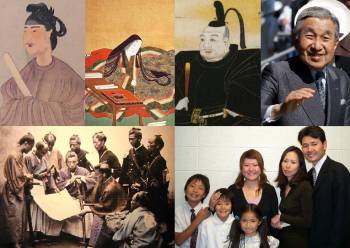 According to both UN and WHO estimates, Japan has the longest life expectancy of any country in the world. According to the UN, it has the third lowest infant mortality rate. However, Japan suffers from a high suicide rate. In 2009, the number of suicides exceeded 30,000 for the twelfth straight year. Suicide is the leading cause of death for people under 30.
According to both UN and WHO estimates, Japan has the longest life expectancy of any country in the world. According to the UN, it has the third lowest infant mortality rate. However, Japan suffers from a high suicide rate. In 2009, the number of suicides exceeded 30,000 for the twelfth straight year. Suicide is the leading cause of death for people under 30.
The Japanese population is rapidly aging as a result of a post–World War II baby boom followed by a decrease in birth rates. In 2009, about 22.7 percent of the population was over 65, by 2050 almost 40 percent of the population will be aged 65 and over, as projected in December 2006. The changes in demographic structure have created a number of social issues, particularly a potential decline in workforce population and increase in the cost of social security benefits like the public pension plan. A growing number of younger Japanese are preferring not to marry or have families. Japan's population is expected to drop to 95 million by 2050.
Japanese society is linguistically and culturally homogeneous with small populations of foreign workers. Japan has a steady flow of about 15,000 immigrants per year. Zainichi Koreans, Zainichi Chinese, Filipinos, Japanese Brazilians, and Japanese Peruvians are among the small minority groups in Japan. In 2003, there were about 136,000 Western expatriates. The most dominant native ethnic group is the Yamato people; primary minority groups include the indigenous Ainu and Ryukyuan peoples, as well as social minority groups like the burakumin.
Upper estimates suggest that 84%–96% of the Japanese population subscribe to Buddhism or Shinto. However, these estimates are based on people affiliated with a temple, rather than the number of true believers. Other studies have suggested that only 30% of the population identify themselves as belonging to a religion. Nevertheless the level of participation remains high, especially during festivals and occasions such as the first shrine visit of the New Year. Taoism and Confucianism from China have also influenced Japanese beliefs and customs. Fewer than one percent of Japanese are Christian. In addition, since the mid-19th century numerous new religious movements have emerged in Japan.
Japanese Culture:
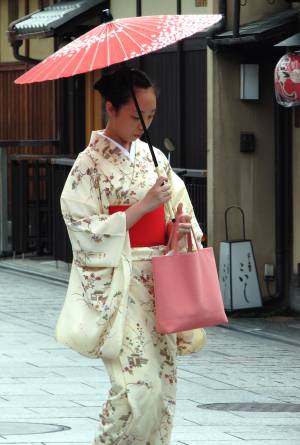 Japanese culture has evolved greatly from its origins. Contemporary culture combines influences from Asia, Europe and North America. Traditional Japanese arts include crafts such as ceramics, textiles, lacquerware, swords and dolls; performances of bunraku, kabuki, noh, dance, and rakugo; and other practices, the tea ceremony, ikebana, martial arts, calligraphy, origami, onsen, Geisha and games. Japan has a developed system for the protection and promotion of both tangible and intangible Cultural Properties and National Treasures. Sixteen sites have been inscribed on the UNESCO World Heritage List.
Japanese culture has evolved greatly from its origins. Contemporary culture combines influences from Asia, Europe and North America. Traditional Japanese arts include crafts such as ceramics, textiles, lacquerware, swords and dolls; performances of bunraku, kabuki, noh, dance, and rakugo; and other practices, the tea ceremony, ikebana, martial arts, calligraphy, origami, onsen, Geisha and games. Japan has a developed system for the protection and promotion of both tangible and intangible Cultural Properties and National Treasures. Sixteen sites have been inscribed on the UNESCO World Heritage List.
Japanese popular culture not only reflects the attitudes and concerns of the present but also provides a link to the past. Japanese cinema, cuisine, television programs, manga, and music all developed from older artistic and literary traditions, and many of their themes and styles of presentation can be traced to traditional art forms. Contemporary forms of popular culture, much like the traditional forms, provide not only entertainment but also an escape for the contemporary Japanese from the problems of an industrial world.
Traditionally, sumo is considered Japan's national sport. Japanese martial arts such as judo, karate and kendo are also widely practiced and enjoyed by spectators in the country. After the Meiji Restoration, many Western sports were introduced in Japan and began to spread through the education system. The Japanese professional baseball league was established in 1936. Today baseball is the most popular spectator sport in the country. Since the establishment of the Japan Professional Football League in 1992, association football has also gained a wide following. Japan has one of the most successful football teams in Asia, winning the Asian Cup four times. Also, Japan recently won the FIFA Women's World Cup in 2011. Golf is also popular in Japan, as are forms of auto racing like the Super GT series and Formula Nippon.
Tourism:
Tourism in Japan attracted 8.3 million foreign visitors in 2008. Neighboring South Korea is Japan's most important source of foreign tourists, with arrivals of 2.4 million in 2010 which made up 27% of total number of tourists visited Japan. Japan has 16 World Heritage Sites, including Himeji Castle and Historic Monuments of Ancient Kyoto (Kyoto, Uji and Otsu Cities). Kyoto receives over 30 million tourists annually. Foreigners also visit Tokyo and Nara, Mount Fuji, ski resorts such as Niseko in Hokkaidō, Okinawa, ride the shinkansen and take advantage of Japan's hotel and hotspring network.
Japanese Cuisine
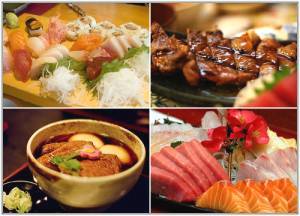 Japanese cuisine refers to traditional-style Japanese food, similar to that already existing in Japan before the end of national seclusion in 1868. In a broader sense of the word, it could also include foods whose ingredients or cooking methods were subsequently introduced from abroad, but which have been developed by Japanese people who have made these methods their own.
Japanese cuisine refers to traditional-style Japanese food, similar to that already existing in Japan before the end of national seclusion in 1868. In a broader sense of the word, it could also include foods whose ingredients or cooking methods were subsequently introduced from abroad, but which have been developed by Japanese people who have made these methods their own.
Japanese cuisine is known for its emphasis on seasonality of food (shun), quality of ingredients and presentation. The Michelin Guide has awarded Japanese cities by far the most Michelin stars of any country in the world (for example, Tokyo alone has more Michelin stars than Paris, Hong Kong, New York, LA and London combined).
Japanese cuisine is based on combining staple foods, typically rice or noodles, with a soup and okazu—dishes made from fish, meat, vegetable, tofu and the like—to add flavor to the staple food. These are typically flavored with dashi, miso, and soy sauce and are usually low in fat and high in salt. A standard Japanese meal generally consists of several different okazu accompanying a bowl of cooked white Japanese rice (gohan), a bowl of soup and some tsukemono (pickles).
The most standard meal comprises three okazu and is termed ichijū-sansai ("one soup, three sides"). Different cooking techniques are applied to each of the three okazu; they may be raw (sashimi), grilled, simmered (sometimes called boiled), steamed, deep-fried, vinegared, or dressed.
As Japan is an island nation, its people eat much seafood. Meat-eating has been rare until fairly recently due to restrictions of Buddhism. However, strictly vegetarian food is rare since even vegetable dishes are flavored with the ubiquitous dashi stock, usually made with katsuobushi (dried skipjack tuna flakes). An exception is shōjin ryōri, vegetarian dishes developed by Buddhist monks. However, the advertised shōjin ryōri at public eating places includes some non-vegetarian elements.
National Staples:
Although there are many staple foods that are considered part of Japan's national cuisine today, rice, noodles and bread are the three most common.
Its fundamental importance to the country and its culture is reflected by the facts that rice was once used as a currency. Japanese rice (gohan) is short grain and becomes sticky when cooked. Most rice is sold as hakumai ("white rice"), with the outer portion of the grains (nuka) polished away. Unpolished rice (genmai) is considered less delicious by most people, but its popularity has been increasing recently because gemmai is more nutritious and healthier than hakumai. A second major rice variety used in Japan is mochi rice. Cooked mochi rice is more sticky than conventional Japanese rice.
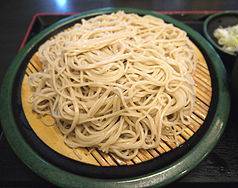 Noodles are an essential part of Japanese cuisine, usually as an alternative to a rice-based meal. Soba (thin, grayish-brown noodles containing buckwheat flour) and udon (thick wheat noodles) are the main traditional noodles and are served hot or cold with soy-dashi flavorings. It is traditionally considered acceptable to slurp the noodles noisily. This is especially common with hot noodles, as drawing up the noodles quickly into the mouth helps cool them down. Chinese-style wheat noodles served in a meat stock broth known as ramen have become extremely popular over the last century.
Noodles are an essential part of Japanese cuisine, usually as an alternative to a rice-based meal. Soba (thin, grayish-brown noodles containing buckwheat flour) and udon (thick wheat noodles) are the main traditional noodles and are served hot or cold with soy-dashi flavorings. It is traditionally considered acceptable to slurp the noodles noisily. This is especially common with hot noodles, as drawing up the noodles quickly into the mouth helps cool them down. Chinese-style wheat noodles served in a meat stock broth known as ramen have become extremely popular over the last century.
Bread (pan) is not native to Japan and is not considered traditional Japanese food, but since its introduction in the 19th century it has become common. Vegetable consumptions has dwindled, but processed foods has become more prominent in Japanese households due to the rising costs of general foodstuffs.
Japanese regional cuisine offers a vast array of regional specialties known as kyōdo ryōri, many of them originating from dishes prepared using traditional recipes with local ingredients. Mainly, there are Kanto region food and Kansai region food. Kanto region foods taste very strong. For example the dashi-based broth for serving udon noodles is heavy on dark soy sauce, similar to soba broth. On the other hand, Kansai region foods are lightly seasoned, with clear udon noodles made with light soy sauce.
National Dishes:
There are many dishes that are considered part of Japan's national cuisine today. Below are listed some of the most common.
Common Japanese savory main and side dishes (okazu) found on a national level:
Grilled and pan-fried dishes (yakimono), stewed/simmered dishes (nimono), stir-fried dishes (itamemono), steamed dishes (mushimono), deep-fried dishes (agemono), sashimi, soups (suimono) and shirumono, pickled, salted, and dressed foods (tsukemono, aemono, sunomono), chinmi
Common Japanese sweets and snacks (okashi, oyatsu) found on a national level:
Japanese-style sweets (wagashi), old-fashioned Japanese-style sweets (dagashi), Western-style sweets (yōgashi), sweets bread (kashi pan)
Sake is a rice wine that typically contains 12%~20% alcohol and is made by multiple fermentation of rice. At traditional meals, sake is considered an equivalent to rice and is not simultaneously taken with other rice-based dishes. Side dishes for sake are particularly called sakana or otsumami. Shōchū is a spirit most commonly distilled from barley, sweet potato, or rice.
Traditional Table Setting:
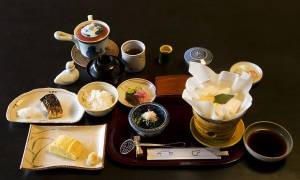 Traditional Japanese table setting is to place a bowl of rice on your left and to place a bowl of miso soup on your right side at the table. Behind these, each okazu is served on its own individual plate.
Traditional Japanese table setting is to place a bowl of rice on your left and to place a bowl of miso soup on your right side at the table. Behind these, each okazu is served on its own individual plate.
Based on the standard three okazu formula, behind the rice and soup are three flat plates to hold the three okazu; one to far back left, one at far back right, and one in the center. Pickled vegetables are often served on the side but are not counted as part of the three okazu.
Chopsticks are generally placed at the very front of the tray near the diner with pointed ends facing left and supported by a chopstick rest, or hashioki.
Japanese Dining Etiquette:
In Japanese dining etiquette, it is customary to say itadakimasu, (literally "I humbly receive") before starting to eat a meal, and gochisōsama deshita, (literally "It was a feast") to the host after the meal and the restaurant staff when leaving.
-
Hot towel: Before eating, most dining places will provide either a hot towel or a plastic-wrapped wet napkin (an oshibori). This is for cleaning hands before eating (and not after). It is rude to use them to wash the face or any part of the body other than the hands.
-
Bowls: The rice or the soup is eaten by picking up the bowl with the left hand and using chopsticks with the right, or vice versa if you are left-handed. Traditionally, chopsticks were held in the right hand and the bowl in the left. Bowls may be lifted to the mouth, but should not be touched by the mouth except when drinking soup.
-
Soy sauce: Soy sauce is not usually poured over most foods at the table; a dipping dish is usually provided. Soy sauce is, however, meant to be poured directly onto tofu and grated daikon dishes, and in the raw egg when preparing tamago kake gohan ("egg on rice"). In particular, soy sauce should never be poured onto rice or soup. It's considered rude to waste soy sauce so moderation should be used when pouring into dishes.
-
Chopsticks: Chopsticks are never left sticking vertically into rice, as this resembles incense sticks (which are usually placed vertically in sand) during offerings to the dead. Using chopsticks to spear food or to point is frowned upon. It is very bad manners to bite chopsticks.
-
Communal dish: When taking food from a communal dish, unless they are family or very close friends, one should turn the chopsticks around to grab the food; it is considered more sanitary. Alternatively, one could have a separate set of chopsticks for communal dishes.
-
Sharing: If sharing food with someone else, move it directly from one plate to another. Never pass food from one pair of chopsticks to another, as this recalls passing bones during a funeral.
-
Eat what is given: It is customary to eat rice to the last grain. Being a picky eater is frowned on, and it is not customary to ask for special requests or substitutions at restaurants. It is considered ungrateful to make these requests especially in circumstances where you are being hosted, as in a business dinner environment. Good manners dictate that you respect the selections of the host.
-
Drinking: Even in informal situations, drinking alcohol starts with a toast (kanpai) when everyone is ready. It is not customary to pour oneself a drink; rather, people are expected to keep each other's drinks topped up. When someone moves to pour your drink you should hold your glass with both hands and thank them.
Episodes:
 |
AFRICAN: Wherever you are in Africa, no meal is complete without a starchy porridge known as fufu. |
 |
BRAZILIAN: An exuberant, colorful mix of Portuguese, African and native foods including some from the Amazon. |
 |
CHINESE: Two thirds of households own a wok and use it regularly, but not everyone knows how to use it properly. |
 |
EGYPTIAN: Beans are used extensively and creatively as a source of protein, fibre, and comfort. |
 |
ENGLISH: "Meat & three veg" originated in the UK with dishes like roast beef, steak and kidney pie, and many more. |
 |
FRENCH: The French have elevated food into an art form. Nowhere else is so much attention paid to what people are going to eat and how. |
 |
HUNGARIAN: A fusion of simple peasant food & the elegant, highly developed cuisine from the days of the Austro Hungarian Empire. |
 |
INDIAN: A vibrant, intensely colorful cuisine. Each region of India has its own style of cooking and distinct flavors. |
 |
INDONESIAN: One of the most vibrant and colorful cuisines in the world, full of intense flavor and varied textures. |
 |
ITALIAN: An long-awaited introduction to the kitchens and restaurants of Australia’s top Italian chefs and home cooks. |
 |
JEWISH: While flavors of the Jewish palate are influenced by geography, the constant for Jews all over the world are the Kosher laws. |
 |
KOREAN: Some of the healthiest food on earth, with a near obsession with the fermented vegetable kimchi. |
 |
LEBANESE: Lebanese cuisine is generous and abundant, and this is some of the most exquisite food in the world. |
 |
MALTESE: The rocky island of Malta is home to some beautiful rustic recipes that sing of Mediterranean flavor and freshness. |
 |
MEXICAN: Authentic Mexican food is vibrant, spicy, delicious and fun. It varies according to which region its from. |
 |
MOROCCAN: One of the most cleverly balanced cuisines on earth; spices are used to enhance the flavor of dishes. |
 |
PAKISTANI: Full of marvelous and diverse dishes, it incorporates elements from its neighbors India, Afghanistan and Iran. |
 |
PERSIAN: From simple dips to hearty stews, food preparation is taken very seriously in Iran and is often a labor of love. |
 |
SOUTH AMERICAN: A fantastic fusion of culinary traditions from indigenous Indians, imported Africans, and the Spanish and Portuguese colonist. |
 |
SRI LANKAN: This beautiful spice island is a rich melting pot of every nationality that has visited and traded with it over the years. |
 |
SYRIAN: One of the highlights of Syrian food is mezza, a generous spread of small dishes and the prelude to even more food! |
 |
TURKISH: Nestled between Asia and Europe, Turkish food is an unique and exotic fusion with influences from many countries. |
Contact Us | Shop | Sitemap | Join Our Team | Investors | Advertise | Web Design Services
Community | Foodies' Choice | Meetup Groups | Chat | Blogs | Forums | Submit Your Site | Resources


